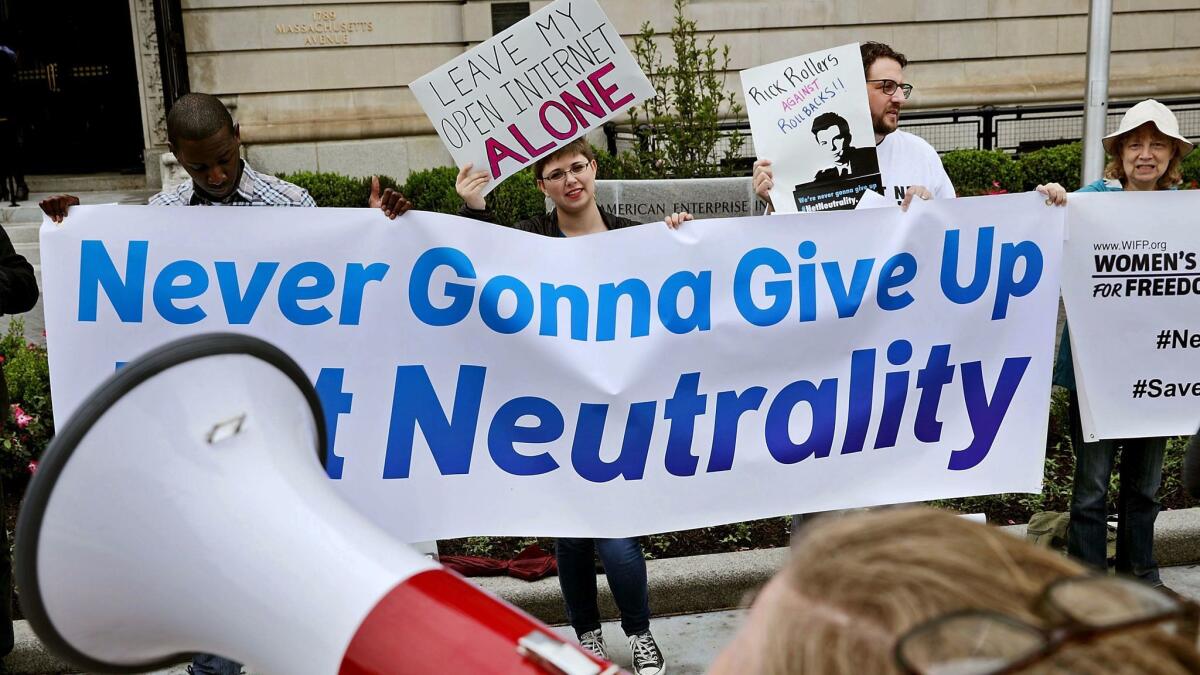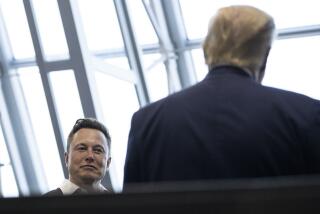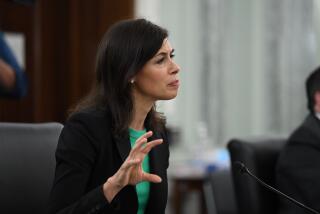Column: FCC Chairman Pai defends his attack on net neutrality by substituting ideology for history

The world of the internet, as seen by Federal Communications Chairman Ajit Pai, is a simple one. Regulation is bad, deregulation is good. Conservatives are victims, and liberals reign supreme. And history doesn’t matter.
That’s the impression one gets from a remarkable speech Pai delivered Tuesday to the R Street institute, a conservative “free market think tank.”
In defending his campaign to repeal FCC regulations governing network neutrality, Pai got the history of regulation and the history of internet technology wrong, repeated his cherry-picked version of internet economics, and took irrelevant potshots at some of his critics in the information industry. He tried to portray his proposal as one that will unleash the wonders of free-market economics to foster more web innovation, but his concerns are plainly ideological.
When it comes to an open internet, Twitter is part of the problem.
— FCC Chairman Ajit Pai
Pai airily dismissed critics who argue that his plan would turn over too much control of the internet to powerful commercial interests. “When you get past the wild accusations, fear-mongering and hysteria,” he said, his “plan to restore internet freedom would return us to the light-touch, market-based approach under which the internet thrived.”
For Pai, internet regulation began in 2015, when his predecessor at the FCC, Obama appointee Tom Wheeler, arranged to reclassify broadband internet as a “telecommunications” rather than “information” service. That gave the FCC the authority to prevent internet service providers serving end users from blocking content providers they didn’t like, charging them more for a “fast lane” into the home, or stifling those offering services that competed with the ISPs’ own.
(What Pai didn’t mention was that Wheeler’s initiative undid a 2002 move by Republican FCC Chairman Michael Powell to classify broadband service as “information,” or that at least two federal courts instructed the FCC that if it wanted to institute net neutrality, it would have to reclassify broadband as “telecommunications.”)
Pai asserts in his talk that there was “no market failure” that justified this “regulatory sledgehammer,” but he’s just wrong. Evidence was mounting that ISPs with market power over the home internet market were exercising it in their self-interest, and not on behalf of subscribers.
As we’ve reported before, the best example was the behavior of Comcast, a cable firm that held a virtual monopoly over internet service in its home territories. In 2007, Comcast was caught degrading traffic from the file-sharing service BitTorrent, which had contracts to distribute licensed content from Hollywood studios and other sources in direct competition with Comcast’s pay-TV business.
In 2010, the Santa Monica-based Tennis Channel filed a complaint with the FCC alleging that Comcast kept it isolated on a little-watched sports tier while giving much better placement to the Golf Channel and Versus, two channels that compete with it for advertising — and which Comcast happened to own. The FCC sided with the Tennis Channel, but was overruled in federal court.
Pai suggests that non-regulation of the internet, thanks to the Telecommunications Act of 1996, has been the key to its technical improvement. “Think back to what the Internet looked like in 1996,” he said. “E-mail was still the killer app. … Forget about YouTube; just downloading a static webpage took 30 seconds, and you paid by the hour for access. And being online also tied up your phone line.”
But that’s a flagrant misreading of the regulatory and technical landscape of that era. In the pre-broadband era — in 1996, for example — we had network neutrality. It wasn’t enforced by government regulators, because it didn’t need to be.
“In practice it was enforced by a vibrant and competitive market,” says Kendall Koning , the coauthor of a history of net neutrality published by Michigan State University. “In those days,” she told me by email, “there were thousands of independent ISPs across the country.” But that market consolidated with the rise of broadband and via inaction by the FCC. “The independent ISP market largely evaporated … resulting in the Cable/DSL duopoly that remains in most of the U.S. to the present day.”
It’s that change that makes the FCC’s guardianship of net neutrality so important today. ISPs such as Comcast, AT&T and Verizon are accumulating enormous power as gatekeepers to the home. In many, if not most, communities across the country, there is no effective ISP competition — users have the choice between cable-based broadband or DSL phone lines, which typically offer inferior speeds and reliability. If Pai really thinks that giving these monopolistic service providers more market power will foster innovation, he’s dreaming. The result is more likely to be stagnating service, at higher prices.
The most perplexing portion of Pai’s speech is his attack on services such as Twitter — “edge providers” as they’re called, because they offer services from outside, but via, the internet’s spine.
“Let’s not kid ourselves,” he told his audience. “When it comes to an open internet, Twitter is part of the problem.” His argument is that such services are the real sources of content discrimination on the web, because they have the power to exclude certain users at will.
That’s a strange argument on several levels. To begin with, those services aren’t subject to FCC regulation. They’re entitled by the 1st Amendment to decide which users they wish to work with, and their decisions are none of Pai’s business.
Pai asserts that Twitter is discriminating against “conservative users’ accounts as opposed to those of liberal users.”
It’s an interesting argument. He appears to be referring in part to Twitter’s decision to “de-verify” the accounts of several racist and hate groups, by removing a blue checkmark from their Twitter pages that tends to give them what has been called a “semiofficial imprimatur.” If Pai is equating Nazi groups with “conservatives,” that says a lot more about him than Twitter.
Pai’s other example is Twitter’s decision to prevent Rep. Marsha Blackburn (R-Tenn.) from running what is essentially a video advertisement using a discredited anti-abortion video and asserting that Planned Parenthood was engaged in “the sale of baby body parts.” The accusation against Planned Parenthood has never been validated, and the organization denies it.
But Twitter didn’t require Blackburn to remove the video or the statement — it just refused to accept money from her campaign to promote it. Both the video and the statement remained available via Blackburn’s Twitter feed.
Pai may be right in stating that protecting “internet freedom” requires a new look at regulation. But if he really believed that, he wouldn’t have to surround his policy proposals with a bodyguard of misrepresentations. Nor would he have to distract the public with entirely irrelevant and plainly ideological complaints about “discrimination” by content providers.
And distraction is what Tuesday’s speech was all about. Pai is asking the FCC to vote on Dec. 14 on a policy that will get the government off the back of the internet so that big business can saddle up. He claims this is in the public interest, but it’s not; it’s in the interest of big ISPs such as Comcast, Verizon and AT&T, and we’d like to know where in the FCC’s enabling legislation it says that their fortunes should be its concern.
Keep up to date with Michael Hiltzik. Follow @hiltzikm on Twitter, see his Facebook page, or email [email protected].
Return to Michael Hiltzik’s blog.
UPDATES:
7:44 p.m.: This post has been updated to correct Kendall Koning’s gender.







